Airbond
Address
Airbond
Pontnewynydd Unit 1, Pavilion Industrial Estate
Pontypool
NP4 6NF
Grossbritannien und Nordirland
Telephone+44 1495 755661
Discover more from us
Follow us on
About us
Airbond bietet Lösungen für alle Garnspleißanforderungen, insbesondere für neue Verbundstoffanwendungen. Airbond ist heute weltweit marktführend beim Spleißen von Verbundwerkstoffen, vor allem hinsichtlich der Spleißergebnisse und der Robustheit/Wartung des Spleißers.
Our product groups
- Technology and Processes
Our application areas / Solutions
Downloads
Documents
Keywords
- splicer
- Spleißer
- waste reduction
- splicing
- yarn recycling
Our Products
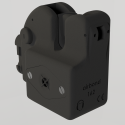
Modell 162
Die Spleißgeräte von Airbond werden weltweit für ihre Einfachheit und Zuverlässigkeit geschätzt. Unter bestimmten Umständen funktioniert das pneumatische Spleißen jedoch einfach nicht. Beispiele beinhalten:
Monofilamente
Falsches Gras
Geflochtenes Garn
Sehr stark geschlichtetes oder beschichtetes Garn
Sehr hochgedrehtes Garn
Unsere Kunden benötigten ein luftbetriebenes Spleißgerät, das Verbindungen in diesen problematischen Materialien herstellt. Das Modell 162 liefert die Antwort. Bei der Verwendung des Modells 162 werden zwei Garnenden überlappt und mit einem feinen Hilfsgarn fest umwickelt und so gebunden, dass eine hochfeste Verbindung entsteht. Für die Verbindungsmethode Modell 162 sind weder Elektromotoren noch Ladegeräte erforderlich; Es nutzt lediglich die gleiche Luftzufuhr wie die übrigen Airbond-Modelle. Schließen Sie es einfach wie gewohnt an die gleiche Luftversorgung an und stellen Sie die umwickelte Verbindung her. Das Modell 162 kann vom Bediener getragen oder am Gatter aufgehängt werden. Die Bedienung erfolgt per Knopf oder Fußpedal. Wie unsere Kunden es erwarten, ist das Airbond-Modell 162 robust, zuverlässig und einfach zu warten.
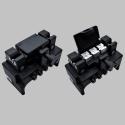
Modell 152
Das halbautomatische Tischspleißgerät für Synthetik mit höherer Fadendichte bis 16000 tex.
Airbond hat seine Position auf dem Verbundwerkstoffmarkt bereits mit erstklassigen Produkten wie den Spleißgeräten der Modelle 113 und 114 etabliert. Diese Produkte sind leicht, handlich und schnell zu warten. Einige Kunden stellten jedoch fest, dass ein Spleißgerät erforderlich ist, das gegen Bedienerfehler immun ist. Der 122 erfüllte dieses Bedürfnis.
Mit seiner Spleißanordnung mit fester Geometrie und den leistungsstarken, sich hin- und herbewegenden Schneidevorrichtungen bot die werkbankmontierte 122 eine vollständig konsistente Leistung auf hohem Niveau. Die Einführung des 3D-Drucks hat es Airbond nun ermöglicht, das Design des alten Modells 122 zu verfeinern.
Der neue 152 ist einfacher und leichter als sein Vorgänger und mindestens genauso stark. Und viel eleganter. Und wie alle anderen Spleißgeräte der Airbond-Reihe ist das 152 robust, zuverlässig und wartungsfreundlich.
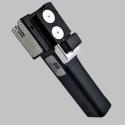
Modell 141
Das Mehrzweck-Auto-Cut-Spleißgerät für Synthetik und Heftklammern mit geringer Anzahl Die 141 besetzt die Marktposition, für die Spleißgeräte ursprünglich entwickelt wurden – relativ feine Garne für industrielle Anwendungen. Der 141 ist mit seiner großen Auswahl an Formaten und Betriebssystemen der ideale Spleißer für diese niedrigeren Stückzahlen. Ob in der Hand, fest oder auf Schienen montiert, der 141 kann die meisten Fabrikanforderungen erfüllen, und wenn sich die Umstände ändern, können neue 141-Karosserien mit der erforderlichen Konfiguration schnell von Airbond gedruckt werden. Das Spleißgerät kann mit einer Strahlzeitschaltuhr oder mit einem Durchflussregelsystem geliefert werden, das der Strahlkammer Luft mit niedrigem Druck zuführt, während der volle Druck für die Schneidegeräte aufrechterhalten wird. Die Messer sind einstellbar, um die Leistung zu verbessern. Das Modell 141 setzt einen neuen Standard als effektives und benutzerfreundliches Werkzeug für Endlos-Kunststoffe, insbesondere moderne Industriefasern. Das Sortiment ist einfach, langlebig und pflegeleicht. Die Spleißgeräte können eine Vielzahl von Garnfeinheiten verarbeiten
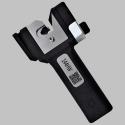
Modell 144
Das manuell geschnittene Spleißgerät für Synthetik mit sehr hoher Fadendichte bis 16000 tex.
Das Airbond Modell 144 ist ein Spleißgerät, das für supergroße Garne entwickelt wurde – unter den richtigen Umständen bis zu etwa 16000 tex.
Das 144 wurde durch Erweiterung des bestehenden Modells 143 entwickelt und behält die meisten Eigenschaften des 143 als leichtes, benutzerfreundliches Werkzeug bei. Und wie das 143 kann dieses Spleißgerät mit einem Griff nach Kundenwunsch oder mit einem sehr kurzen Sockel geliefert werden, um es in beengten Umgebungen einsetzen zu können. Wie der 143 kann auch der 144 mit einem Durchflussregelsystem geliefert werden, das der Strahlkammer Luft mit variablem Druck zuführt, während der Hauptleitungsdruck unverändert bleibt.
Mit unterschiedlichen, innovativen Techniken zum Verbinden spröder Garne wie Glas und Kohlenstoff und zum Verbinden von inhärent starken Aramiden ist das Modell 144 international als benutzerfreundliches Spleißgerät für superschwere Fäden anerkannt.
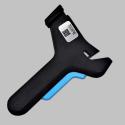
Modell 701
Das Mehrzweck-Spleißgerät für Synthetik mit höherer Fadendichte bis 7000 tex.
Das Airbond Modell 701 ist ein leichtes, benutzerfreundliches Werkzeug, das hauptsächlich für den Verbundwerkstoffmarkt entwickelt wurde. Passend zur Leistung unserer größeren Spleißgeräte macht die 701-Reihe saubere, starke Verbindungen in Garnen mit sehr hoher Nummer, typischerweise Glasfaser- und Kohlefaser-Rovings mit 4800 Tex oder mehr. Mit unterschiedlichen, innovativen Techniken zum Verbinden spröder Garne wie Glas und Kohlenstoff und zum Verbinden von inhärent starken Aramiden ist das Modell 701 international als benutzerfreundliches Spleißgerät für hohe Fadenzahlen anerkannt.
Leichter als die meisten unserer anderen Spleißgeräte, ist das eigentliche Spleißgerät vor Verschleiß geschützt und sicher in einer schlagfesten ABS-Hülle untergebracht.
Die Spleißgeräte der Serie 701 widerstehen Beschädigungen im Betrieb besser als die meisten Produkte auf dem Markt; aber wenn sie mal schief gehen, sind sie einfach zu warten. Sie können in wenigen Minuten ab- und wieder aufgebaut werden. Der Einsatzbereich des 701 ist durchaus beachtlich. Eine einzigartige und patentierte Form der Spleißkammer und des Spleißsystems ist so leistungsfähig, dass eine einzige Spezifikation Garne mit sehr unterschiedlichen Feinheiten handhaben kann.





